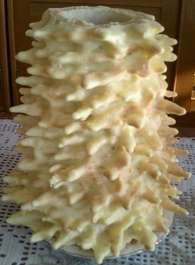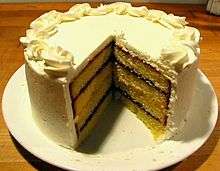Šakotis
Lithuanian šakotis or raguolis ("tree cake"; literally "branchy"[1]), Polish sękacz[2], Belarusian bankukha (Belarusian: банкуха)[3][4][5] is a Polish, Lithuanian and Belarusian traditional spit cake. It is a cake made of butter, egg whites and yolks, flour, sugar, and cream, cooked on a rotating spit in an oven or over an open fire.
 Lithuanian šakotis | |
| Alternative names | Sękacz (Poland) Bankukha (Belarus) |
|---|---|
| Type | Cake |
| Region or state | Lithuania, Poland, Belarus |
| Created by | German Baumkuchen |
History
The cake became popular during the Polish-Lithuanian Commonwealth (1569–1791). Its origins are attributed to either the Italian Queen Bona Sforza of Poland or the Baltic tribe of Yotvingians. The Yotvingians, first mentioned in 5th century B.C. as neuri, well known as great warriors and hunters, while Bona Sforza is known to have implemented many agriculture, infrastructure and manufacture reforms.[6] But most likely it's a variation of the German Baumkuchen.[7]
Its name means "branched tree" or "tree with many branches" due to its distinctive shape (it is often conical, like a pine tree, and with the drips as branches). It is baked in a time- and labor-intensive process,[8] by painting layers of dough onto a rotating spit in a special open oven or over an open fire.
It can be decorated with chocolate and flower ornaments, but it is often served plain. Šakotis is one of the most important desserts in Lithuanian celebrations, especially at weddings or other special occasions such as Christmas.[9] It was the sweet chosen to represent Lithuania in the Café Europe initiative of the Austrian presidency of the European Union, on Europe Day 2006.
In May 2015, in Druskininkai, Lithuania the record of the biggest šakotis was broken with 372 centimetres (12.20 ft) height and 85.8 kilograms (189 lb) weight.[10]
In 2006, Masurian sękacz was included in the list of traditional products of the Warmian-Masurian Voivodeship in Poland.[11]
In 2019, the bankukha recipe from Porazava was included in the official list of historical and cultural heritage of Belarus.[12] In north-western Belarus, bankukha is known as a wedding cake made of 60 egg yolks[13][3]
Other regional varieties
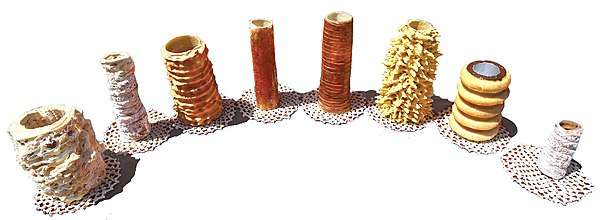
- Austria – Prügelkrapfen
- Belarus – bankukha (derived from the German word Baumkuchen meaning "Tree cake")
- Czech Republic – Trdelnik
- France – Gâteau à la broche
- Luxembourg – Baamkuch has become a traditional dish served mostly on special occasions, such as weddings, christenings, etc. Yet, the cake is available all year around in certain supermarkets.
- Poland – Sękacz
- Lithuania – Šakotis or Raguolis (Bankuchenas as known in western Lithuania, itself word is loanword from German Baumkuchen) is a similar cake also cooked on a spit, normally over an open fire
- Sweden – Spettekaka with the protected geographical indication (PGI) registered by the EU
- Hungary – Kürtőskalács is a similar cake also cooked on a spit
- Slovakia – Skalický trdelník with the protected geographical indication (PGI) registered by the EU
- Turkey – Makara tatlısı is a similar cake also cooked on a spit.
- Indonesia – Spekkoek (kue lapis legit or spekuk) was developed during colonial times in the Dutch East Indies. The firm-textured cake is an Indo (Dutch-Indonesian) version of the European multi-layered spit cake.
Gallery
- Preparation of Sękacz in Podlachia
- Plain, low types of soft Šakotis
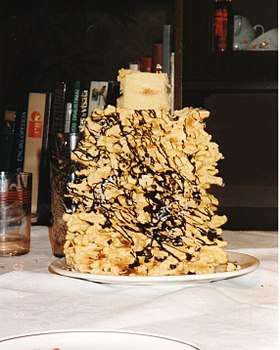 Šakotis decorated with chocolate chips and coconut shavings
Šakotis decorated with chocolate chips and coconut shavings- Tall Šakotis, decorated with flowers
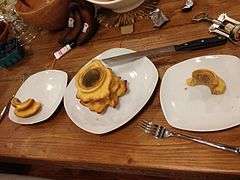 The cake (center) served onto plates (right and left) showing characteristic cake layers resembling growth rings of trees
The cake (center) served onto plates (right and left) showing characteristic cake layers resembling growth rings of trees
See also
References
- Lankauskas, Gediminas (2015). The Land of Weddings and Rain: Nation and Modernity in Post-Socialist Lithuania. U of Toronto P. pp. 208–11. ISBN 9781442612563.
- Goyan Kittler, Pamela; Sucher, Kathryn P.; Nelms, Marcia (2011). Food and Culture (6th ed.). Cengage Learning. p. 174. ISBN 978-0538734974.
- Торт банкуху из Свислочского района могут внести в список культурного наследия - BelTA, 30 April 2019. Quote: В поселке Порозово, что на самом краю Беловежской пущи, сохранили мастерство приготовления банкухи. До сих пор не известно, откуда был привезен рецепт. Похожий пирог под название сэнкач выпекают в Польше, а в Литве такой торт известен как шакотис. [In the village Porazava on the edge of the Bielaviezha Forest, the art of making the bankukha is still preserved. It is still unknown where the recipe came from. A similar cake called sękacz is made in Poland, while in Lithuania this cake is known as šakotis]
- Торт-гриль. Как в Беларуси пытаются сохранить традиции приготовления уникального свадебного пирога [The grilled cake. How Belarusians try to preserve the traditions of making a unique wedding cake] - Sovetskaya Belorussiya – Belarus' Segodnya, 17 May 2019. Quote: Развеем сомнения тех, кто на фотографии узнал брендовый литовский шакотис. Он и есть. Если быть точнее, то банкуха — это его белорусский «хенд мейд»‑аналог, за приготовлением которого на кухне нужно провести не менее семи часов. [Let us clear the doubts of those who recognize the iconic Lithuanian šakotis in the photo. It is it. To be exact, bankukha is its hand-made analogue, and to cook it you have to spend not less than seven hours in the kitchen]
- Гастротур по Беларуси: аутентичные блюда и кулинарные традиции Синеокой [A gastronomic tour through Belarus: dishes and culinary traditions of the Blue-Eyed Land] - Belarus.by, Official website of the Republic of Belarus. Quote: Жительницы белорусско-польского приграничья хранят уникальный рецепт блюда, которое раньше считалось непременным атрибутом любой свадьбы. Праздничный торт банкуха, внешне напоминающий литовский шакотис, считается тем лучше приготовленным, чем он выше и "ветвистее". [Women from the Belarusian-Polish borderland have a unique recipe of a dish that used to be a necessary attribute of any wedding. The festive cake bankukha, that looks similar to the Lithianian šakotis, is considered to be best if it is higher and has many branches.]
- Klaus Klöppel: Polnische Ostseeküste: Danzig, Masuren, Baedeker, ISBN 3-8297-1171-9 Archived January 7, 2014, at the Wayback Machine
- Weichselbaum, Elisabeth; Benelam, Bridget; Soares Costa, Helena (2009). Synthesis report No 6: Traditional Foods in Europe (PDF). EuroFIR. pp. 45–46. ISBN 0-907667-67-8.
- Bremzen, Anya von (2014). Det goda sovjetiska köket: Minnen, mat och längtan (in Swedish). 2244. p. 242. ISBN 9789186729592.
- Baker, Mark; Presser, Brandon; Dragicevich, Peter; Richmond, Simon; Symington, Andy (2012). Lonely Planet Estonia, Latvia & Lithuania. Lonely Planet. p. 43. ISBN 9781743213049.
- Lietuvoje pasiektas rekordas: iškeptas didžiausias pasaulyje šakotis
- Spiel, Jadwiga A.; Pliszka, Monika; Borowski, Jerzy; Gutkowska, Agnieszka (2011). "Skład chemiczny, cechy sensoryczne i właściwości przeciwutleniające sękacza mazurskiego (Chemical composition, sensoric features, and antioxidants properties of 'Masurian Sękacz' cake)". Żywność. Nauka. Technologia. Jakość (in Polish and English). PTTŻ. 18 (6): 120, 131.
- Гісторыка-культурнай каштоўнасцю Беларусі прызналі пірог «банкуха» з Поразава. Што гэта такое? [Bankukha cake from Porazava recognized as an object of historical and cultural value of Belarus. What is it?] - Nasha Niva, 16 December 2019
- ГУРМАН. Что такое банкуха, и как ее приготовить [GOURMET. What is a bankukha and how to make it] - Minsknews.by, 16 June 2019
